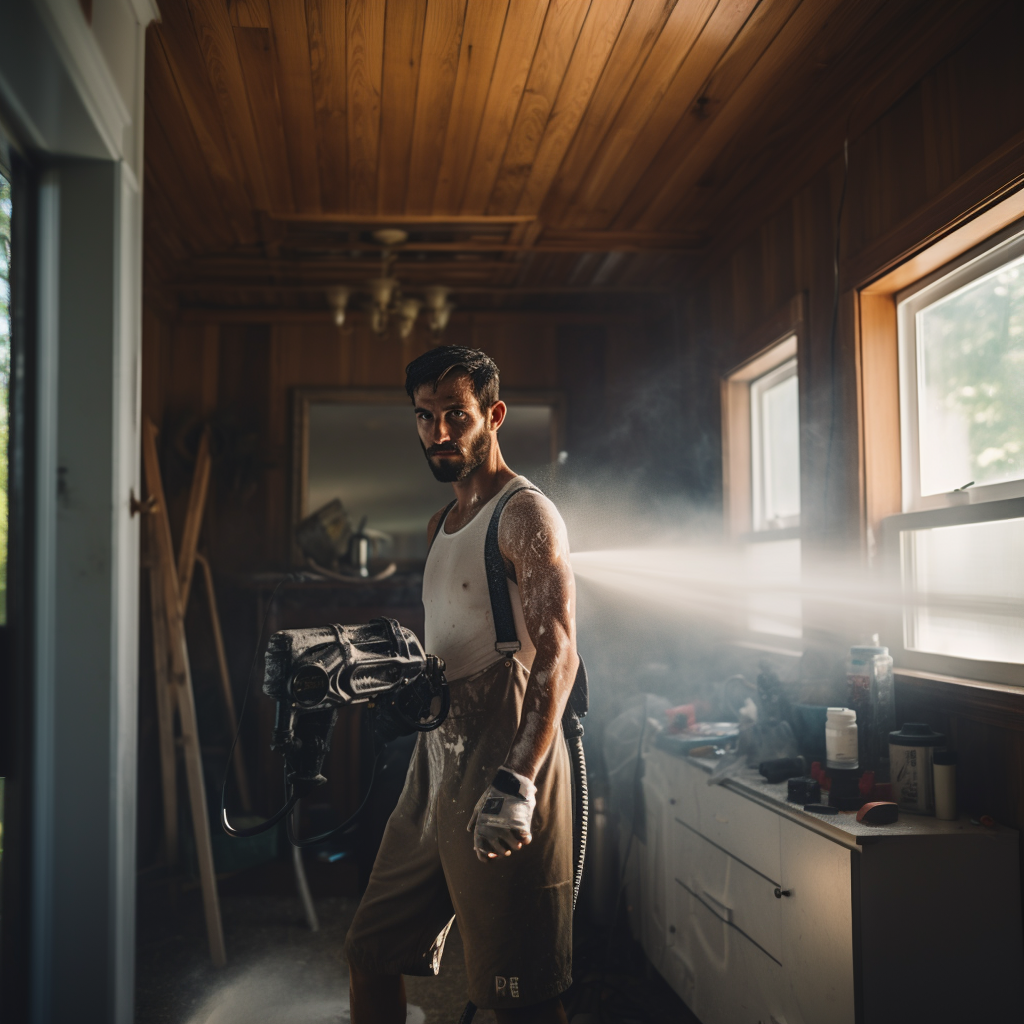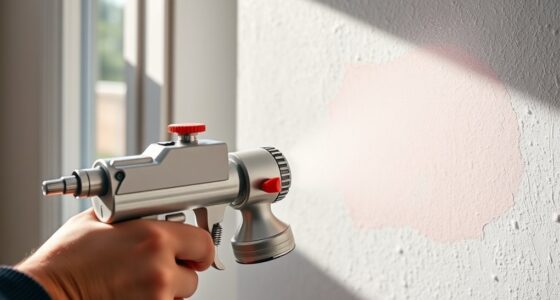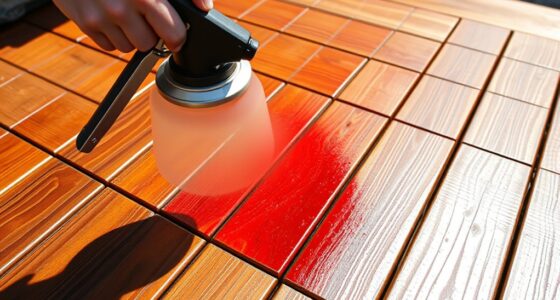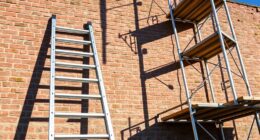To spray a fence efficiently and get an even coat, maintain a steady hand and keep the sprayer 8-12 inches from the surface. Overlap each pass by about 50% and move at a consistent pace to prevent drips and missed spots. Use proper equipment settings and test on scrap first. For a flawless finish, combine spraying with careful brushing for tricky areas. Continue exploring for more expert tips to perfect your technique.
Key Takeaways
- Test spray pattern and equipment settings on scrap or hidden areas before full application.
- Maintain a steady distance of 8-12 inches from the fence surface for even coverage.
- Overlap each spray pass by approximately 50% to ensure uniform coats.
- Keep the sprayer moving consistently to prevent drips and uneven paint layers.
- Revisit tricky spots and thin areas with a brush for a flawless finish.
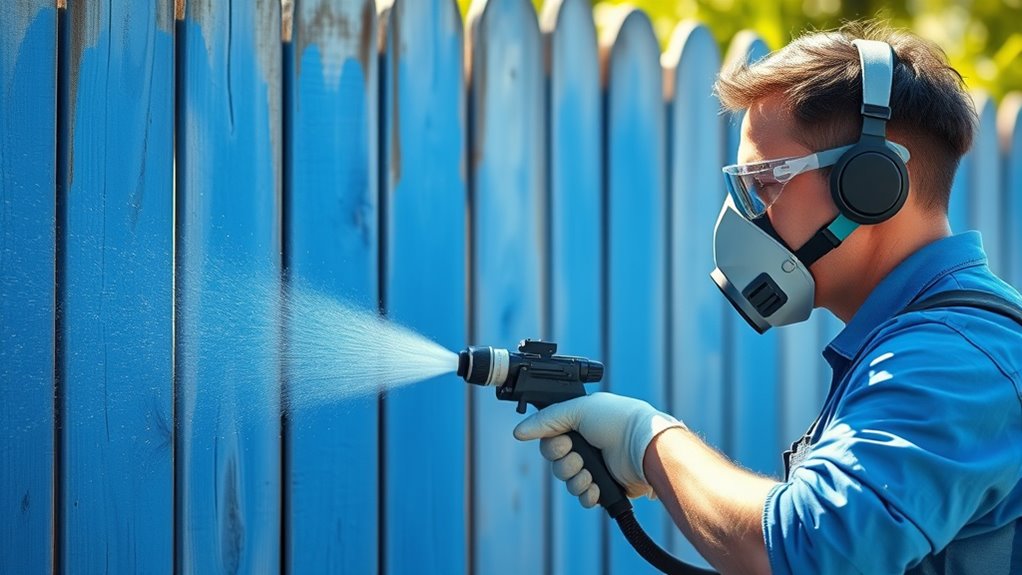
Spraying a fence with a paint sprayer is an efficient way to achieve a smooth, even finish in less time than traditional brushes or rollers. While the sprayer handles most of the work, mastering your brush techniques and choosing the right paint are vital to a professional-looking result. Proper brush techniques can help you reach tricky spots, edges, and corners that the sprayer might miss or overspray. For example, use a small, angled brush to carefully paint intricate areas or edges where the spray can’t reach. Hold the brush at a consistent angle and apply light, even strokes, blending each pass seamlessly into the sprayed areas. This guarantees that the finish looks uniform, without obvious brush marks or overlaps.
When it comes to paint selection, opt for high-quality exterior paints designed for wood or the material of your fence. These paints are formulated for durability, weather resistance, and adhesion, which are essential for outdoor fencing. Choose a paint with a suitable consistency—usually a medium viscosity—that’s not too thick for your sprayer but thick enough to provide good coverage. If you pick a paint that’s too runny, it may cause drips and overspray; if it’s too thick, you’ll need to thin it appropriately to prevent clogging the spray gun. Always check the manufacturer’s recommendations for thinning and application to guarantee optimal flow and finish.
Before you start spraying, test your paint and spray pattern on a scrap piece or a hidden area of the fence. This helps you fine-tune your technique and adjust your equipment, ensuring you don’t waste paint or create uneven patches. When applying the paint, keep the sprayer moving at a steady pace, about 8 to 12 inches from the surface, to avoid drips and uneven coats. Overlap each pass by roughly 50% to maintain consistent coverage and minimize striping. If you notice thin spots or missed areas, go back and touch them up with your brush, especially around corners or detailed sections.
Frequently Asked Questions
What Type of Paint Is Best for Fence Spraying?
Choosing the right paint type is like selecting the perfect brushstroke for a masterpiece. For fence spraying, you’ll want a high-quality, acrylic latex paint, which offers durability and smooth application. Before you start, proper fence preparation is vital—clean and sand the surface. Opt for a paint designed for outdoor use, ensuring it withstands weather and UV rays, giving your fence a vibrant, lasting finish with minimal effort.
How Do I Prevent Overspray During Fencing?
To prevent overspray during fencing, start with thorough fence prep—clean and cover surrounding areas with drop cloths. Use proper spray techniques by maintaining a consistent distance and angle, and adjust the spray pattern for even coverage. Practice on scrap material first to get comfortable. Applying multiple light coats rather than thick ones helps minimize overspray, ensuring a clean, professional finish without wasting paint or damaging nearby surfaces.
What Safety Gear Should I Wear?
Think of safety gear as your shield in a battlefield. You should wear protective clothing to guard your skin from paint splatters and fumes. A respirator mask is essential to filter out harmful particles and vapors, keeping your lungs safe. Never skip these precautions; they’re your armor against health risks. Proper gear guarantees you can focus on your task without worry, achieving a flawless finish while staying safe.
How Do I Clean the Sprayer After Use?
After finishing, you should clean your paint sprayer to guarantee proper equipment maintenance. First, disconnect the sprayer and empty any remaining paint. Rinse the system with water or a suitable cleaning solution, running it through the hoses and nozzle. Use a brush if needed to remove stubborn paint. Proper cleaning prevents clogs and extends your equipment’s life, making future projects smoother and more efficient.
Can I Spray a Wet or Damp Fence?
Imagine your fence as a blank canvas waiting for a fresh start. You might wonder if spraying a wet or damp fence is like trying to paint on a soaked canvas—messy and uneven. For best results, guarantee proper fence prep and choose the right paint. Applying paint on a dry surface helps the sprayer work smoothly, providing an even coat. Avoid spraying on damp fences to prevent drips and uneven coverage.
Conclusion
With a little patience and proper prep, painting your fence with a sprayer becomes simple and swift. By blending bold brushstrokes with best practices, you’ll bring beauty to your boundary without a bother. Remember, a steady hand and strategic spraying secure a smooth, stunning surface. So, seize your spray, stay steady, and smoothly showcase a splendid, streak-free fence that’s sure to impress. Happy spraying and hassle-free fencing!
Franz came aboard the Paint Sprayer Zone team with a background in both journalism and home renovation. His articulate writing style, combined with a passion for DIY projects, makes him an invaluable asset. Franz has a knack for breaking down technical jargon into easy-to-understand content, ensuring that even the most novice of readers can grasp the complexities of paint sprayers.


